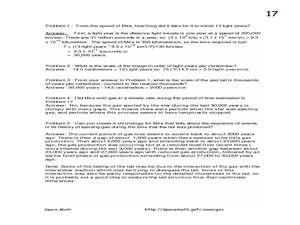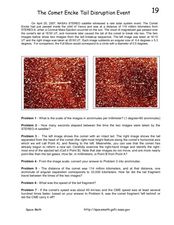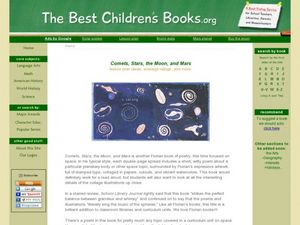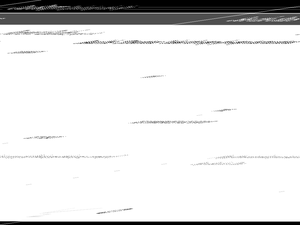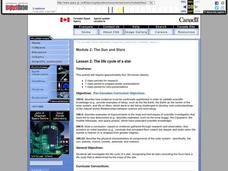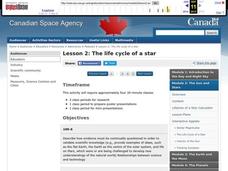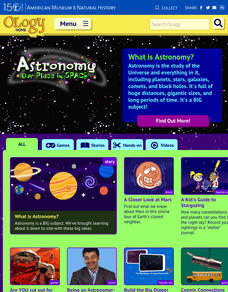Curated OER
Exploring the Sky: Reading Maria's Comet
Discover the science behind astronomy. After reading the book Maria's Comet, which is about a young woman who breaks new ground by becoming a female astronomer, young learners practice reading comprehension with...
Curated OER
Sweet Candy Comets
Fourth graders use candy to make a comet. In this lesson, 4th graders examine the role comets have played throughout history, students watch NASA videos about comets and complete the lesson by making an edible model of a comet. This...
Curated OER
A Star Sheds a Comet Tail!
In this comet tails and stars worksheet, students read about the star Mira and the vast clouds of gases it emits. They use a photograph from the Galaxy Evolution Explorer satellite to solve 5 problems about the scale of the image, the...
Curated OER
Asteroid, Comet, or Meteor?
For this asteroid, comet and meteor worksheet, students complete a chart by determining which of 8 given characteristics belong to asteroids, comets or meteors.
Curated OER
Spotting an Approaching Asteroid or Comet
In this asteroid and comet worksheet, students read about the formula used to determine the brightness of asteroid. They apply this formula to solve 2 problems about asteroids and their brightness.
Curated OER
The Comet Encke Tail Disruption Event
In this comet tail disruption learning exercise, learners solve 7 problems using two images from NASA's STEREO satellite showing the breakup of the comet's tail. Students analyze the diagram and use the scale to solve the problems about...
Curated OER
Space Science: Adventure is Waiting
These full-color handouts feature two activities. The first is a reading on comets, meteors, and meteoroids. Your space science learners will examine ten phrases and determine which of the three each characterizes. The second activity...
Curated OER
Comets, Stars, the Moon, and Mars
Students read the book Comets, Stars, the Moon, and Mars about space. In this space lesson plan, students make their own poetry book about space.
K5 Learning
Miss Mitchell's Comet
Maria Mitchell discovered a comet, became the first female astronomer in the United States, and even has a crater on the moon named after her! Learn more about her passion for the stars with an informative reading passage, followed by...
Curated OER
See the Stars
Students explore the nighttime sky. In this space science instructional activity, students read the book Maria's Comet and and investigate the sky using their naked eyes. Students compare the view of their naked eyes to the view of a...
Curated OER
The Life Cycle of a Star
Students investigate the life cycle of a star through research. Once research is complete, students prepare posters and present findings to class. Flash animation is included to help students visualize life cycle of star researching.
Curated OER
The Life Cycle of a Star
Young scholars investigate the life cycle of a star and make conclusions based on evidence, research, and observation. In this lesson on space and scientific investigation, students describe the relationships between science and...
Scholastic
Falling Stars
Young scientists explore meteors, and comets by reading a fascinating passage in the plan, then answering 13 questions about them. Then, learners perform a WebQuest and learn amazing things about gravity, robots, and black holes. The...
Curated OER
Asteroid, Comet, or Meteor?
In this asteroid, comet, and meteor graphic organizer worksheet, students compare and contrast asteroids, comets, and meteors as they mark the characteristics of each.
Curated OER
Unit 2 Sun & Stars
Students describe stellar objects using terms such as stars, planets, satellites, orbits and light. In this sun and stars unit, students research stellar objects through seven individual lessons discovering star characteristics, how...
American Museum of Natural History
Planetary Mysteries
A website all about planetary mysteries—it's a one-stop-shop for all things, stars, planets, and space travel. Scholars read an astronomy overview to discover the page's big ideas, then choose from the plethora of resources, including...
Curated OER
Constellation Prizes
Students study meteors, meteorites, and comets by reading and discussing a related New York Times article about the Leonid meteor showers and the methods that scientists are using to study from these meteors. They create a comet in the...
Curated OER
Scavenger Hunt: Who am I?
In this solar system worksheet, students use an on line source to find the names of the people who discovered the planets, comets, asteroids, black holes and the idea of the big bang theory.
Curated OER
Star Stories
Students study constellations and the stories that go with them. They identify at least 3 constellations in the night sky. Students recognize some of the myths surrounding the constellations. They create their own constellation and myth.
American Museum of Natural History
What Do You Know About Astronomy
Develop an understanding of the universe. Learners answer 10 multiple choice questions about several topics in astronomy. Questions contain information about the age of the universe, gravitational attraction, galaxies, planets and comets...
Howard Hughes Medical Institute
Distribution of Elements in Earth’s Crust
How do scientists know the difference between a meteorite from space and a regular rock from the earth? Scholars read a passage and answer comprehension questions about the creation of the solar system. They extrapolate the main ideas to...
Curated OER
Solar System Review
After a unit on the solar system, this resource would be a motivating way for students to review what they have learned. The presentation does not have in-depth questions, but could be used as a quick review of basic concepts relating to...
Curated OER
Scale Model of the Solar System
Students work in groups of 4-6 for the experiment/activity part of this exercise. Students know that earth is the third planet from the sun in a system that includes the moon, the sun, eight other planets and their moons, and smaller...
Curated OER
Star Child Astronomy
Students gain understanding of the relationship of Earth within the Solar System. They increase knowlegde of the planets, sun, moon, meteoroids, asteroids and comets.




